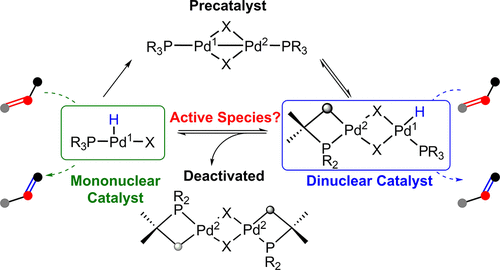当前位置:
X-MOL 学术
›
ACS Catal.
›
论文详情
Our official English website, www.x-mol.net, welcomes your feedback! (Note: you will need to create a separate account there.)
Dinuclear PdI Catalysts in Equilibrium Isomerizations: Mechanistic Understanding, in Silico Casting, and Catalyst Development
ACS Catalysis ( IF 12.9 ) Pub Date : 2020-03-17 , DOI: 10.1021/acscatal.9b05345 Sriman De 1 , Nardana Sivendran 2 , Bholanath Maity 1 , Nico Pirkl 2 , Debasis Koley 1 , Lukas J. Gooßen 2
ACS Catalysis ( IF 12.9 ) Pub Date : 2020-03-17 , DOI: 10.1021/acscatal.9b05345 Sriman De 1 , Nardana Sivendran 2 , Bholanath Maity 1 , Nico Pirkl 2 , Debasis Koley 1 , Lukas J. Gooßen 2
Affiliation

|
The unique reactivity profile of the dinuclear PdI complex [PdI(μ-Br)tBu3P]2 as an isomerization cocatalyst has enabled orthogonal tandem processes ranging from styrene syntheses to biodiesel refining. We have now elucidated the mechanistic basis of its distinct catalytic profile by density functional theory calculations and experimental studies. Activation of the catalyst proceeds intramolecularly, giving rise to a dinuclear complex composed of a reactive palladium hydride and an inert palladacycle. This complex mediates double bond migrations with an energy span of 9.5 kcal/mol, which is well below those calculated for known catalysts. Its dissociation leads to an even more active monophosphinopalladium hydride catalyst and an inert dinuclear bispalladacycle. In the main deactivation pathway, two mononuclear Pd species react with each other, liberating a hydrogenation product and regenerating the catalyst precursor [PdI(μ-Br)tBu3P]2. The experimentally observed buildup of dinuclear palladacycles during the catalysis is, thus, the result of conversion of a binuclear into mononuclear Pd–H catalyst. Phosphines, which would deactivate metathesis cocatalysts, are not liberated at any stage. This explains the unique suitability of [PdI(μ-Br)tBu3P]2 for isomerizing metatheses. The mechanistic insights were used for the in silico casting of a catalyst generation, targeting complexes with a reduced barrier toward the formation of dinuclear Pd–H species, a low energy span of the catalytic cycles, and increased barriers either toward deactivation or, alternatively, toward dissociation to short-lived mononuclear complexes. Complexes with bisadamantyl-n-butylphosphine ligands were identified as lead structures. Experimental studies with model catalysts confirmed the validity of the predicted structure–activity relationship.
中文翻译:

平衡异构化中的双核Pd I催化剂:机理理解,硅铸造和催化剂开发
双核Pd I复合物[Pd I(μ-Br)t Bu 3 P] 2的独特反应活性由于异构化助催化剂已实现了从苯乙烯合成到生物柴油精制的正交串联工艺。我们现在已经通过密度泛函理论计算和实验研究阐明了其独特的催化特性的机理基础。催化剂的活化在分子内进行,产生了由反应性氢化钯和惰性帕拉达环组成的双核络合物。该络合物介导的双键迁移的能量跨度为9.5 kcal / mol,远低于已知催化剂的计算范围。它的离解导致活性更高的单膦钯氢化物催化剂和惰性双核双spalaadacycle。在主要的失活途径中,两种单核Pd物质相互反应,释放出氢化产物并再生出催化剂前体[Pd]。I(μ-Br)t Bu 3 P] 2。因此,在催化过程中实验观察到的双核Palladacycles堆积是双核转化为单核Pd-H催化剂的结果。使灭活复分解助催化剂失活的膦在任何阶段都不会释放。这解释了[Pd I(μ-Br)t Bu 3 P] 2的独特适用性用于异构化复分解。该机制的见解被用于在计算机上生成催化剂的计算机模拟,其目标是降低对双核Pd-H物质形成的壁垒,催化循环的能量跨度低以及对失活或壁垒增加的壁垒的配合物。趋向于离解到短寿命的单核复合物。具有双金刚烷基-正丁基膦配体的配合物被鉴定为铅结构。用模型催化剂进行的实验研究证实了预测的构效关系的有效性。
更新日期:2020-04-23
中文翻译:

平衡异构化中的双核Pd I催化剂:机理理解,硅铸造和催化剂开发
双核Pd I复合物[Pd I(μ-Br)t Bu 3 P] 2的独特反应活性由于异构化助催化剂已实现了从苯乙烯合成到生物柴油精制的正交串联工艺。我们现在已经通过密度泛函理论计算和实验研究阐明了其独特的催化特性的机理基础。催化剂的活化在分子内进行,产生了由反应性氢化钯和惰性帕拉达环组成的双核络合物。该络合物介导的双键迁移的能量跨度为9.5 kcal / mol,远低于已知催化剂的计算范围。它的离解导致活性更高的单膦钯氢化物催化剂和惰性双核双spalaadacycle。在主要的失活途径中,两种单核Pd物质相互反应,释放出氢化产物并再生出催化剂前体[Pd]。I(μ-Br)t Bu 3 P] 2。因此,在催化过程中实验观察到的双核Palladacycles堆积是双核转化为单核Pd-H催化剂的结果。使灭活复分解助催化剂失活的膦在任何阶段都不会释放。这解释了[Pd I(μ-Br)t Bu 3 P] 2的独特适用性用于异构化复分解。该机制的见解被用于在计算机上生成催化剂的计算机模拟,其目标是降低对双核Pd-H物质形成的壁垒,催化循环的能量跨度低以及对失活或壁垒增加的壁垒的配合物。趋向于离解到短寿命的单核复合物。具有双金刚烷基-正丁基膦配体的配合物被鉴定为铅结构。用模型催化剂进行的实验研究证实了预测的构效关系的有效性。



























 京公网安备 11010802027423号
京公网安备 11010802027423号